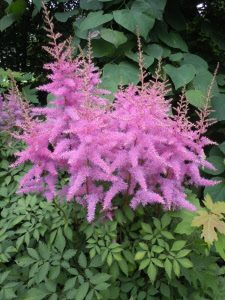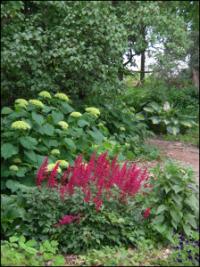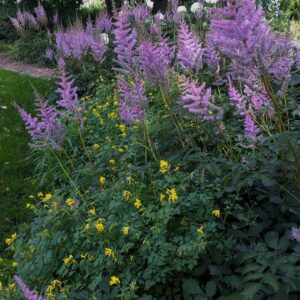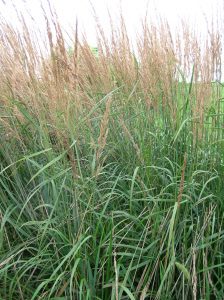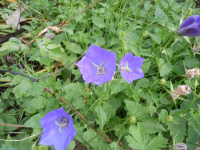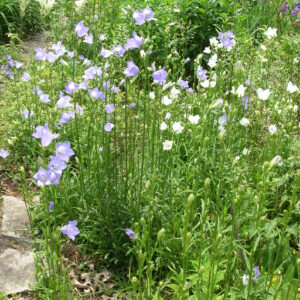Black Walnut Tolerant
Showing 17–24 of 106 results
-
Astilbe andresii ‘Amethyst’ Z 5-8
pink plumes flowering in July, with oxblood tinged foliage
OUT OF STOCK
Three foot tall pink plumes flowering in July, with oxblood tinged foliage
Size: 36"x 24"
Care: sun to part shade, moist soil essential. Immune walnut toxicity
Wildlife Value: attracts butterfliesAstilbe is Greek from a meaning “without” and stilbe meaning “lustre” referring to the fact that the leaves are not shiny. Early hybrid by George Arends, nurseryman from Ronsdorf, Gemany (1862-1952).
-
Astilbe andresii ‘Fanal’ Z 4-8
Marlboro red plumes in June
Striking Marlboro red plumes in June
Size: 24"x 18"
Care: sun to part shade, moist soil. Immune walnut toxicity
Wildlife Value: attracts butterflies
Awards: Royal Horticultural Society Award of Garden MeritAstilbe is Greek from a meaning “without” and stilbe meaning “lustre” referring to the fact that the leaves are not shiny. Cross of A. japonica and A. davidii made by Arends, nurseryman from Ronsdorf, Gemany (1862-1952), in 1930.
-
Astilbe chinensis luo xin fu in China Z 4-9
Pink plumes in mid-summer atop fern-like foliage. More tolerant of sun and well-drained soil than the hybrids.
Pink plumes in mid-summer atop fern-like foliage. More tolerant of sun and well-drained soil than the hybrids.
Size: 24” x 24” spreads
Care: Sun to shade in moist or moist well-drained soil
Native: Siberia, China, KoreaAstilbe from “the Greek word for without” and stilbe meaning “lustre” referring to the fact that the leaves are not shiny. 1st described for the West by botanist Carl Johann Maximowicz in 1859 and then named Hoteia chinensis. Liberty Hyde Bailey termed this plant “graceful” in the early 1900’s.
-
Bouteloua gracilis Blue grama Z 4-9
One sided, horizontal, purple tinged spikelets looking like a row of eyelashes above the petite clump of thin grass blades, July-October
One sided, horizontal, purple tinged spikelets looking like a row of eyelashes above the petite clump of thin grass blades, July-October
Size: 2' x 12"
Care: sun in dry to moist well-drained soil
Native: all US except SE & NW, Wisconsin native
Wildlife Value: Host for caterpillars of several skipper butterflies. Deer resistant
Awards: Great Plants for Great Plains Grass of the Year 2008For the Navajo this was a “life medicine” and an antidote to an overdose of “life medicine.” Also used to cure sore throats and cuts – chew on the root and blow on the cut. Navajo girls carried it in the Squaw Dance. Hopi made baskets from this grass. Zuni made brooms & hairbrushes from it. Several tribes ate this & made bedding for their animals from this. Lakota children played a game using this grass: Most of the stems have two flowers on them. Children competed to see who could find the stems with three flowers, like finding a four-leaf clover. First collected for horticulture by Humboldt & Bonpland who scoured Latin America from 1799-1804.
-
Calamagrostis brachytricha Diamond grass, Feather reed grass Z 4-9
Extraordinary, voluptuous plumes with pink caste, September to November, much underused. One of internationally known garden designer Piet Oudolf’s 100 “MUST HAVE” plants, Gardens Illustrated 94 (2013)
Extraordinary, voluptuous plumes with pink caste, September to November, much underused. One of internationally known garden designer Piet Oudolf’s 100 “MUST HAVE” plants, Gardens Illustrated 94 (2013)
Size: 4' x 30"
Care: Full sun to part shade in moist to moist well-drained soil.
Native: East Asia
Awards: England’s Royal Horticultural Society Award of Merit & Great Plants for Great PlainsDescribed in 1854 in Synopsis Plantarum Glumacearum.
-
Calamagrostis x acutiflora”Karl Forester” Feather reed grass
Completely, reliably erect grass - winner perennial plant of year award 2001.
Completely, reliably erect grass – winner perennial plant of year award 2001.
Size: 3-5' x 2'
Care: sun to part shade in moist to moist well-drained soil. Cut back in late winter.
Awards: Perennial Plant Association Plant of the Year 2001This is a natural cross of Calamagrostis epigeos and Calamagrostis arundinacea, natives of Asia and Europe. German nurseryman Karl Forester’s (1874-1970) keen eye spotted this in the Hamburg Botanic Garden. He listed this in his nursery catalog in 1939. Under Nazi domination he risked it all by keeping Jewish friends & workers. After WW II his nursery was the only perennial supplier in East Germany. This grass sent from Denmark to the US in 1964.
-
Campanula carpatica Tussock bellflower, Carpathian bellflower Z 3-8
In summer blue, violet or white bells
In summer blue, violet or white bells.
Size: 12” x 12”
Care: Sun moist well-drained soil
Native: Carpathian mountains in central Europe
Awards: England’s Royal Horticultural Society Award of Merit.Campanula is Latin means little bell. In 1629 Parkinson described campanulas as “cherished for the beautie of their flowers…” Young roots of this species were eaten in “sallets.” Introduced to European gardens from the Carpathian Mountains in 1774. Sold by McMahon’s Philadelphia nursery in the early 1800’s. Probably cultivated by Jefferson at Monticello.
-
Campanula persicifolia Peach-leafed bellflower Z 3-8
June – July (with deadheading) white or blue open-facing bell flowers along the top foot of the erect, leafless stems.
June – July (with deadheading) white or blue open-facing bell flowers along the top foot of the erect, leafless stems.
Size: 24-36" x 10"
Care: Sun in moist well-drained soil.
Native: EuropeCampanula is Latin meaning little bell. Persicifolia means leaves like a peach. Both white and blue ones of C. persicifolia grew in English gardens before 1580, then described in literature by Scottish botanist Robert Morison (1620-1683). English herbalists prescribed C. persicifolia for ailments of the mouth and throat and to clear complexions.

